- Home
- William Shatner
Up Till Now Page 13
Up Till Now Read online
Page 13
Fate intervened. One afternoon I was standing on the balcony of the equestrian center and when I looked into the ring I saw a demonstration that changed my life. An obviously severely handicapped child was sitting on a horse; a handler was leading the horse around the ring as spotters walked on either side of this child. This was the first time I had ever seen riding therapy. This was my introduction to a program called Ahead with Horses.
As I learned, when a physically or emotionally handicapped child sits astride a horse something magical transpires. Kids who can’t walk get motion. Kids who can’t talk garble something to the horse. Kids who have difficulty relating to the world somehow communicate with these horses. I saw children who literally could not hold up their heads lead horses through intricate exercises. Watching these children interact with horses will move people beyond tears. You see these children who have been afflicted with terrible handicaps just blossom, you see them smile and laugh.
I’d found my charity. So since 1990 the Hollywood Charity Horse Show has raised funds to support Ahead with Horses. A few years later we began adding other charities, among them Camp Max Straus, a summer camp especially for inner-city kids with physical, emotional, behavioral, or social interaction problems that would make it almost impossible for them to attend traditional camps.
The Wells Fargo—they have become the primary sponsor— Hollywood Charity Horse Show usually takes place in late April. In addition to a silent auction, top-notch entertainment, and an arena show, we serve a wonderful dinner. Tickets are expensive, in 2007 they were $250, but every dollar—not almost every dollar—every single dollar goes directly to our charities.
So if you’d like to make a difference in a child’s life, please visit www.Horseshow.org for details. Now let us return to Angie Dickinson’s naked body.
The set had been almost completely cleared. I pulled back the covers of the bed and slid into it. “Wait a second,” Angie said loudly. “You know what, Roger, I think we need the makeup people.”
Roger yelled, “Get George back in here. Tell him he can stay.” “And the lighting director. We definitely need him.” “Fred, come on back in too.” “And the grips, maybe they should stay here too. Oh, and you know what? Sound, we’ve got to have the sound men here, don’t we?”
I propped myself up on my elbow. Eventually she named just about everyone on the entire crew—you can stay, let him stay, you’d better stay. The only person she didn’t name was a craft services guy—someone who served lunch—and he wandered off the set but snuck back on later.
Finally we shot the scene. It wasn’t nearly as... hard as I had feared. Everything was so technical. Move your nose jusssst a little to the left, please, that’s good. Now put your arm down. Now just move back and forth, wait wait wait, your arm’s in the wrong place. Makeup! Please touch up Angie’s eye shadow, thank you.
By the mid-1960s I was no longer even being offered parts that were going to make me a star. Gloria and I were living in a comfortable home—with the requisite pool—in Sherman Oaks with our three girls, Leslie, Melanie, and Lisbeth. Truthfully, I was struggling. It seemed like the more I worked the further behind I got. My parents would come down from Montreal to see their grandchildren and I can vividly remember my father sitting by the pool and asking me, “So? How are you doing?”
I told him the truth. “It’s tough, Dad. I got the mortgage, I got all the things the girls need...”
“Can I help you?” he asked.
I probably smiled at that offer. “Dad,” I told him, “you don’t have enough money to help me.”
I really didn’t know what I was going to do. I felt trapped: I was doing what I had dreamed of doing, working as an actor. I’d appeared on Broadway and in important movies and on every respected television show. I’d worked with the best producers and writers and directors. I’d gotten many superb reviews and even won awards—but I wasn’t earning enough money to support my family. Had I been single, with few responsibilities, I would have been fine. So I began to wonder if this was the time to find another career.
If there was something else I could have done, this was the time I would have done it. What I could not possibly know then was I was ending one chapter of my life, but another vitally important chapter was about to begin. That was chapter five.
FIVE
After the pilot for the Alexander the Great series failed to get picked up and the very well-reviewed For the People was canceled after thirteen episodes, I did a third series pilot for which I had little hope. I was much more excited about starring in a beautiful play entitled The Hyphen, which had been written especially for me by Norman Corwin. I so admired Corwin, who was regarded as the greatest playwright in radio; at McGill I’d performed in all of his plays.
A few years earlier he’d written the film Lust for Life, for which he’d been nominated for an Academy Award for Best Screenplay, Kirk Douglas had been nominated as Best Actor, and Anthony Quinn had won the Oscar for Best Supporting Actor. Norman just called me out of the blue and asked me to play the lead role in this play. My role was that of a scientist who was visited by a fairy, who had come to show me that the world is much more than a collection of scientific facts. We opened at the University of Utah, in Salt Lake City, and received tremendous reviews, and we were planning to take it to New York.
While we were getting the play ready to move to New York my agent called to tell me that NBC had decided to pick up the pilot. My first series was actually going on the air. Perhaps you’ve heard of it. It’s called... Star Trek?
Well, if you haven’t heard of it apparently you’ve been living in a cave on a remote atoll somewhere in the South Pacific or have been participating in some bizarre experiment. Star Trek is arguably the best known, most enduring, and influential television series ever produced. If you haven’t actually seen an episode of this show, perhaps you might have run across some of the merchandise? Some of the estimated two billion dollars’ worth of Star Trek merchandise that has been sold. Maybe you’ve seen one of the many dozens of collectible models of the Starship Enterprise, including the Wrath of Khan battle-damaged Enterprise, some models which light up or play recordings of my character, Captain James Tiberius Kirk; or the series of dozens of collectible plates including twentieth-anniversary editions of “Amok Time,” “Journey to Babel,” “Piece of the Action,” “The Trouble with Tribbles,” or the twenty-fifth-anniversary Mr. Spock, Captain Kirk, Chekov, Mr. Sulu (with or without a certificate), a 3D McCoy plate and a 3D Scotty plate as well as Classic Kirk, Classic Uhura, and Classic Spock plates; or the Starfleet Academy T-shirt, DJ Spock T-shirt, Captain Kirk “Risk Is Our Business” T-shirt and the infant/toddler T-shirt; the Starfleet Academy mug, disappearing image transporter mug, the “I Slept with Kirk” mug and “I Slept with Kirk” large mug, the Enterprise stein, the tankard, collection of glasses, Icee cups, and glow-in-the-dark cups; the complete DVD sets of the original series, Star Trek: The Next Generation, Star Trek: Deep Space Nine, Star Trek:Voyager, Star Trek:The Animated Series, or videos of the ten Star Trek feature films; numerous recordings of the music; the literally thousands of different action figures, among them nine- and twelve-inch clothed figures, the twelve-inch classic edition Chekov, twelve-inch Dr. McCoy, and twelve-inch Engineer Scott, the nine-inch Kirk Casual Attire and the nine-inch Command Edition Captain Kirk, the five-inch fuzzy Tribbles, six-inch Mirror Scotty Ltd. Edition, seven-inch Commander Kirk and Command Chair, the Dr. McCoy Action Figure European Special Edition, fourteen-inch porcelain Dolls from Hamilton Collectibles and Acrylic Sculptures; the United Federation of Planets blanket; Limited Edition Hand Phaser Prop replica kit, limited edition fortieth-anniversary bronze Phaser and the Danbury Mint Gold-Plated Laser; “Her Name is Enterprise” Journal; over one hundred novels including Ashes of Eden, hundreds of comic books and magazines and guides; Star Trek trading card sets from more than a dozen different manufacturers, including cards with glossy finishes, 3D cards, moving-picture cards, holographic pi
cture cards, autographed cards, and even gold-plated cards, as well as playing card sets and trading card tins and card holders; visible Klingon postcards; Star Trek scripts; annual Christmas tree ornaments; the “Trek Chicks Rock” trucker’s hat; Franklin Mint chess set, checkers set, 3D chess set in pewter, 3D chess set in wood; dozens of different watches, including the twenty-fifth-anniversary watch and video game watch, wall clock, desk clock, alarm clock, and traveling clock; the Evil Spock “Screw York Logic” women’s cap and T-shirt and Evil Spock T-shirt; snow globes; dartboard; limited edition gold stamp, commemorative stamp book; endless thousands of autographed photographs; film cell art including Mr. Spock and Captain Kirk pictured next to the Golden Gate Bridge surrounded by four film cells; sets of movie posters; Enterprise telephones and telephone and address books; silver coins; ties; the Spock decanter; commemorative spoons; pins; matchbooks; plastic rings; dice; numerous different jigsaw puzzles from twenty-five pieces to a thousand pieces; Enterprise earrings; belt buckles; a pocket knife; lunch boxes; a rubber doormat and a mouse pad; photon torpedo candies, numerous key rings and key chains; bookplates and bookmarks; wanted posters; wrapping paper; party invitations; cocktail napkins; dozens of different Halloween costumes “for children of all ages,” latex masks and Spock ears; life-size cardboard stand-ups; a command bridge model; Frisbees; kites; View-Master sets; wrist communicators; sticker sets and sticker books; a disc gun; water pistol; space flashlight; yo-yos; hand-held electronic games; Spock bop-bag; interactive VCR board game; Star Trek the game; Star Trek trivia game; Silly Putty; freezicle kit; Super Phaser Target Game; easy painting sets, coloring books, activity books; marbles; pen and pencil sets and pencil boxes; handheld pinball game, window scenes set, soft poseable figures; Mego play bridge; Klingon Disruptor Figure; Enterprise glider; bread cards; puzzle boards, sticker books; telephone cards from dozens of countries around the world, including the United States, Germany, Chile, Estonia, Holland, and Austria; piggy banks; CD holders and albums; coasters; holograms; velvet paintings; motion-picture props; fan club and convention magazines; kitchen aprons, lighters; bobble-head dolls; a wallet, raincoats and umbrellas; swivel belt-clip phaser holster...
Star Trek grew to become better known than any television series in history. It was broadcast on network television for only three years, there were only seventy-nine episodes, but for reasons that many wise men have tried for many years to explain, it eventually gained a great and extraordinarily loyal following. Small fan clubs grew into conventions that attracted as many as twenty thousand people, many of them dressed as their favorite characters and villains. It has generated more than two billion dollars in merchandise sales, Google lists 1.3 million sites for Star Trek merchandise, and at any time eBay generally has more than twelve thousand items for sale. And the actors, in particular myself and Leonard Nimoy, became among the most recognized people in the world.
For example, just before the shah of Iran was deposed in 1979 I was invited by his government to participate in a photography safari, in which we would shoot pictures of a black leopard at night. The shah had set up wilderness preserves to allow animals native to that area to survive and prosper. So we drove several hundred miles outside the capital of Tehran to this beautiful wilderness. We drove along the Caspian Sea where fisherman were using techniques a thousand years old to catch sturgeon. And finally we came to this small village on the seacoast. The area we were in had been part of the Ottoman Empire; for centuries nomadic tribes had swept down from Russia to stop there on their wanderings. The village in which we stopped had possibly been an oasis at one time, but now it consisted of a single street with perhaps three stores and a kabob house. Our guide asked if we wanted to stop for a kabob. Well, of course we did. This was truly outside civilization as I knew it to be and I wanted to experience as much of it as possible. We walked into this restaurant, it was a shed really, it had no more than six uncovered wooden tables and badly worn chairs. There were several men sitting there, one of them a Turkoman, a large man made larger because he was wearing the traditional Turkoman garb: the tall black bear hat, a red jacket with sashes through it, and high black boots. He looked right at me for a moment, then turned and looked toward the back of this small room. There was a small black-and-white television set sitting on top of a cabinet—and that set was showing Star Trek. This Turkoman waved his kabob through the air and declared, as if it were perfectly normal to see me sitting in a kabob house in a village on the Caspian Sea, “Captain Kirk!”
Star Trek was the most wonderful thing that ever happened to me. I look back upon it as the miracle that changed my life. In fact, it has changed your life, too. All the extraordinary opportunities I’ve been given since that time can be traced directly to that series. So if I hadn’t done Star Trek none of the things that followed would have happened, therefore you wouldn’t be reading this book. To fill the time you’re spending reading it, you would have had to find other things to do. And your life would be different.
It continues to astonish me how many people know it so well. And know me. In 2001 I was producing and directing a low-budget film named Groom Lake. We were shooting in the small town of Bisbee, Arizona, which is about twenty miles from the Mexican border and a popular crossing point for illegal immigrants. One night while I was working, my now-wife, Elizabeth Shatner, was invited by a border patrolman to ride along the border on horseback with him.
It was a very unusual experience, she told me. So several nights later Liz and I went on patrol along the Mexican border. We began by driving deep into the Sonoran Desert until we reached a campfire where horses were waiting for us. Even though we were in the desert it was very cold and we were wearing heavy jackets and Western hats. There was no moon that night and we could barely see twenty feet in front of us. The agents gave us their night goggles; when we put them on everything appeared in a greenish tint. Then we rode into the night. The agents stayed on foot; we trailed about fifty yards behind them.
In a sense this was like a sad game in which everyone was playing a role. The agents knew from experience where the Mexicans were going to try to cross the border. Suddenly the agents started running and our horses started galloping behind them. Within minutes the agents had rounded up about twenty-five Mexicans who had just crossed the border. By the time we got there the Mexicans were squatting on the ground, listening to the agent. “Look,” he told them. “You’re going back across the border. Don’t come back this way.”
Liz and I were sitting up on our horses, bundled into jackets, hats on our heads, wearing these goggles that covered most of our faces. And suddenly, one of these illegal immigrants looked at me, first with curiosity, then with recognition, and said finally in a heavily accented English, “That is Captain Kirk?” Then he smiled and asked, “We have autograph?”
Obviously I never dreamed that any of this would happen when I did the pilot. If I had I would have done it much sooner. Star Trek was created by an experienced television writer named Gene Rodden-berry. In his proposal to NBC he described his show as Wagon Train— a very successful Western series about the adventures of a wagon train as it rolled west—to the stars. Initially Roddenberry wanted Lloyd Bridges to play the lead role of Captain Pike, and when Bridges turned him down the part went to Jeffrey Hunter, who was best known for playing Jesus Christ in the movie King of Kings. The pilot also starred an actor named Leonard Nimoy playing an alien named Mr. Spock. As Leonard remembers Roddenberry telling him, “I’ve got this alien and I want him to look kind of satanic.” Basically that consisted of a severely curved eyebrows and large pointed ears.
NBC turned down the Star Trek pilot, complaining that there wasn’t enough action in it, that it was “too cerebral.” It required the audience to think too much. But the concept was so intriguing that the network agreed to pay for a second pilot. Apparently Hunter’s wife began making all kinds of demands on Roddenberry, who finally fired him. To replace him he needed an actor who was not too cerebral. So he offered the role
to Jack Lord, who later starred in Hawaii Five-0. Supposedly Jack Lord asked for 50 percent ownership of the show. That’s when Roddenberry called and asked me to look at the pilot with him. I guess he felt I was the perfect choice for the lead role in a show that wasn’t too intelligent for its audience and whom he didn’t have to pay a lot of money. And for me, all I had to do was replace Jesus Christ.
The first pilot was a wonderful, magical story in which Jeffrey Hunter is lured to a planet by an alien species in hopes that he will mate with a deformed human female who had survived a crash landing there. To convince him to produce children with her, they transformed her into various types trying to figure out what would attract him. Psychologically it was very interesting. But it was much more than interesting. It was original.
It’s very difficult all these years later, after Star Wars and Close Encounters and all the other space stories, to appreciate how extraordinarily innovative it was. The genius of Roddenberry’s Star Trek was that its characters were normal people—even the alien Spock— who had normal relationship problems—when they weren’t busy saving the universe. After watching the pilot I told Roddenberry that I thought the characters took themselves much too seriously. They made everything they did seem so monumental. Something as simple as “Turn left,” became: We are about to execute an extremely difficult maneuver that we have been carefully trained to do but accomplishing this incredibly risky task will require every bit of our ability and intelligence and we have no way of knowing what the impact of this attempt will be upon the universe. These guys have been on this voyage for years, I told him. Sometimes a left turn is simply a left turn. It’s just another workday until something dramatic changes it. I see it having more humor, more fun.
“Okay,” he agreed. “I go along with that.”

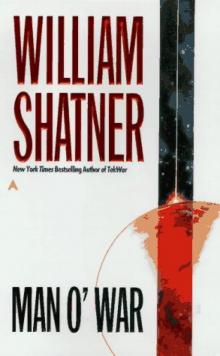 Man O' War
Man O' War Shatner Rules
Shatner Rules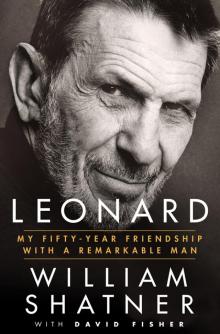 Leonard
Leonard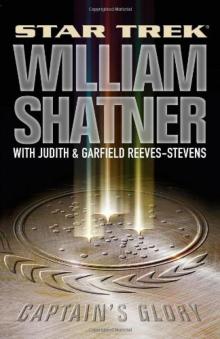 Captain's Glory
Captain's Glory Captain's Glory зпвш-9
Captain's Glory зпвш-9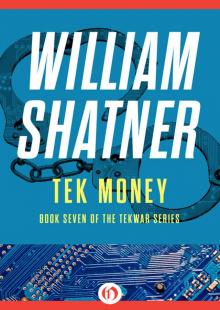 Tek Money
Tek Money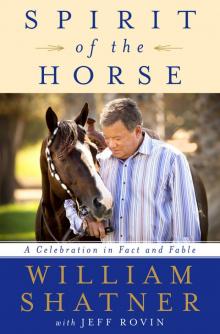 Spirit of the Horse
Spirit of the Horse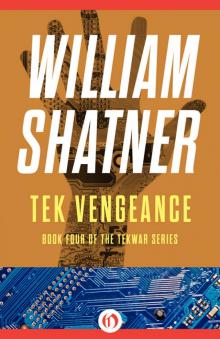 Tek Vengeance
Tek Vengeance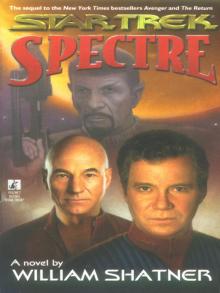 Spectre
Spectre Zero-G
Zero-G Tek Kill
Tek Kill Collision Course
Collision Course TekLab
TekLab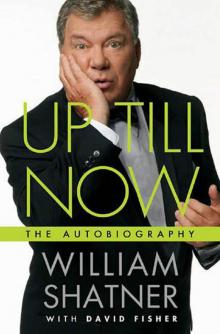 Up Till Now
Up Till Now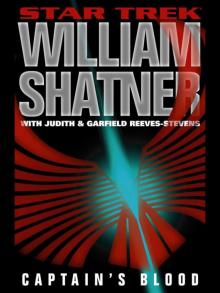 Captain's Blood
Captain's Blood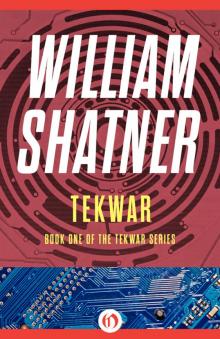 TekWar
TekWar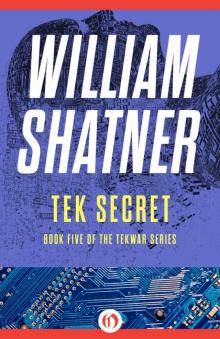 Tek Secret
Tek Secret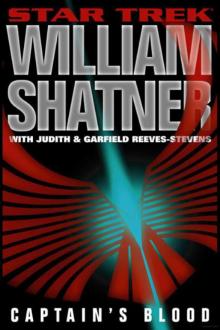 Captain's Blood зпвш-8
Captain's Blood зпвш-8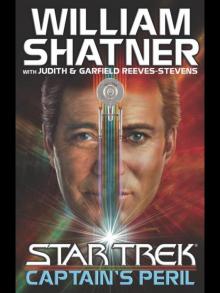 Captain's Peril
Captain's Peril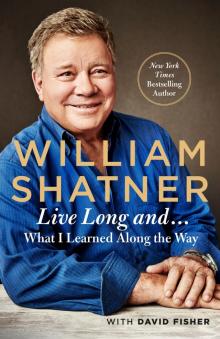 Live Long and . . .
Live Long and . . .